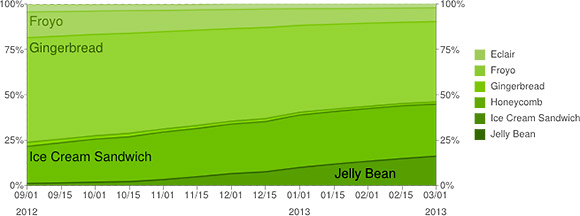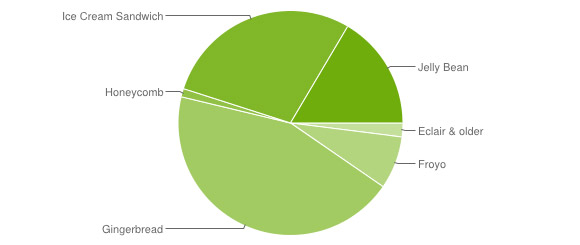Current Android version distribution shows growth for Jelly Bean
6 March 2013 by Olav Hellesø-Knutsen Google has released figures showing that most Android handsets still run 2.3 Gingerbread but Jelly Bean continue to grow. The distribution of all other versions decreased since last month
iPhone and Windows Phone users tend to highlight the fact that there are still older version of Android available and that this is a problem for Android users. Android fragmentation is a search query that returns 1.940.000 results on Google Search. For most users, this is not a problem. For developers, this could be a problem. For each new version of the operating system, Google has added services that do not exist in older versions. A developer needs to decide if he want to use any of the new API's (services) but then exclude older handsets from running the app. The Gingerbread version has the largest user group with 44% of the total devices that accessed Google Play within a 14-day period ending in the beginning of March 2013. There has only been a slight change since last month. Older versions such as Froyo 2.2, Eclair 2.0-2.1 and Donut 1.6 has a user base of 9.7%. The share of Gingerbread 2.3 handsets is constantly decreasing. Jelly Bean 4.2 is the only versions with an increased user base since last month. Jelly Bean increased from 13.6% in February to 16.5% in March. Most high-end handsets available today has Ice Cream Sandwich installed. Jelly Bean will soon be the most installed version on high-end and flagship models. Most of the new handsets announced at Mobile World Congress last month will be shipped with Jelly Bean 4.1/4.2. Ice Cream Sandwich is still being installed on most entry-level devices. Keep in mind that these numbers will change when smartphone vendors releases an updated OS version for their smartphones.
Alternatively post this in the Esato forum Please sign in to your Esato account to leave a comment regarding this article Are all those pre ICS ones handsets that are presumably not able to update to anything more recent?
The overview shows current install base of phones accessing the Google Play store. After a major OS update for a popular smartphone model, the version percentages will change slightly. When the popular Galaxy S III received the 4.1 Jelly Bean we saw a bump from 4.0 to 4.1. Samsung has sold over 40 million of the Galaxy S3. There is over 400 million phones running Android now, so i theory we could see 10% reduction of ICS devices and an increase of 10% for Jelly Bean. Google has not reported which handsets are still running ICS im happy with 2.3.4 on my neo v, no need for rubbish ics on it. Also im not keen on jellybean for new handsets as you lose flash, no thanks! I currently have Adobe Flash Player 11.1 installed in my GS3 and I use the Skyfire web browser for some stubborn websites.
WRT ICS, I have to disagree, maybe SE/Sony's version was terrible, but IMO it was a great leap in Android both UI and functionality wise. It also brought great battery life in Android4.0.4. My GS2 is still sitting on 4.0.4, it runs beautifully, fast, fluid and very smooth with great battery life. Naturally I prefer JB, Project Butter has my GS3 running like a well oiled machine. [ This Message was edited by: Tsepz_GP on 2013-03-07 11:22 ] So basically what this means is less than 50% are running a high end Android phone. Basically tells us that Androids meaningful global market share is actually less than 25%. Most of their phones are mid and low end.
JB runs sweet on the Xperia T and looks very nice. Google Now is quite good too - a worthy upgrade.
|












 RSS feed
RSS feed